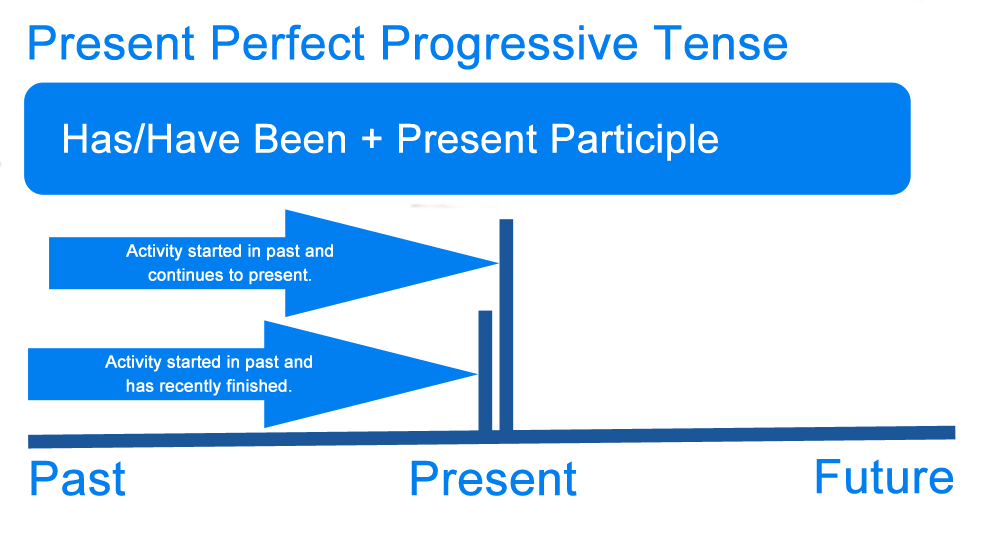Present perfect progressive definition: The present perfect progressive tense (also called the present perfect continuous) is an English verb tense that is most often used to express actions that began in the past and continue to the present.
What is the Present Perfect Progressive?
The present perfect progressive is a complicated English verb tense. It is a combination of the present progressive verb tense and the present perfect verb tense.
The present perfect progressive verb tense most often expresses actions that began in the past and continue to the present.
Present Perfect Progressive Examples
Here is a depiction of what the present perfect progressive tense describes.

As you can see, an event or action begins in the past and continues up to the present.
Here are a few examples,
- The water has been running all day.
- In this example, the running water is the action that started in the past. It continues to the present because it is still running (nothing stopped it).
- I have been working on my essay all weekend.
- In this example, I started working on my essay at some point in the past, and my work continues to the present.
Forming the Present Perfect Progressive
The present perfect progressive verb tense is relatively easy to form because its components remain fairly consistent.
To form the present perfect progressive:
- Subject + has/have + been + present participle (and “-ing” to end of the verb)

Examples of Present Perfect Progressive with Different Subjects
- with “to watch”
- with “to breathe”
- I have been breathing.
- You have been breathing. (singular)
- He/She/It has been breathing.
- We have been breathing.
- You have been breathing. (plural)
- They have been breathing.
Uses of the Present Perfect Progressive
 The present perfect progressive is most often used to express actions that started in the past but continue to the present.
The present perfect progressive is most often used to express actions that started in the past but continue to the present.
This means that the action itself began in the past. However, it continues to the present and has not yet stopped. It is still occurring as the sentence is written or read.
For example,
- The sirens have been blaring for hours.
- The blaring sirens are the action that started in the past. This action continues to the present because nothing has stopped the action. It is a continuous/progressive action in that it keeps going.
It can also refer to actions that started in the past but just recently stopped.
For example,
- She has been sleeping all day and is now ready to go out.
- In this example, she is no longer sleeping. This action, however, has current relevance because it is why she is now ready to go out.
Additionally, this tense can refer to something that is a relatively new habit that has been happening for some time. In this sense, it takes on the general meaning, “lately” or “recently.”
For example,
- Recently, I have been watching a lot of television.
- This example shows that the action is a new habit but has been happening often. The action is not necessarily happening now.
- Have you been working out lately?
- This example is similar to the prior one, but it is in the form of a question. The speaker is asking whether or not the other person has recently picked up the habit of working out.
Progressive Tense and Dynamic Verbs
 Typically, dynamic verbs are used in sentences with the progressive verb tenses. Stative verbs do not really work in the progressive tense because the progressive tense explicitly expresses actions.
Typically, dynamic verbs are used in sentences with the progressive verb tenses. Stative verbs do not really work in the progressive tense because the progressive tense explicitly expresses actions.
- A dynamic verb is a verb a subject can do.
- A stative verb expresses a state of being.
Dynamic examples in the present perfect progressive tense:
- I have been running.
- You have been screaming.
- They have been dancing.
It seems awkward to use stative verb in a progressive verb tense, as shown below,
- They have been liking their new appliances.
- We have been being creatively lately.
Because progressive tenses express an action, it is best to use dynamic verbs.
Summary
Define present perfect progressive: the definition of present perfect progressive is the English tense used to describe continuing actions starting in the past that continue to the present.
In summary, the present perfect progressive tense is:
- a combination of the present progressive tense and the perfect tense
- used to express action that started in the past and continues to the present.
- formed with “has/have been” and a present participle
Contents
